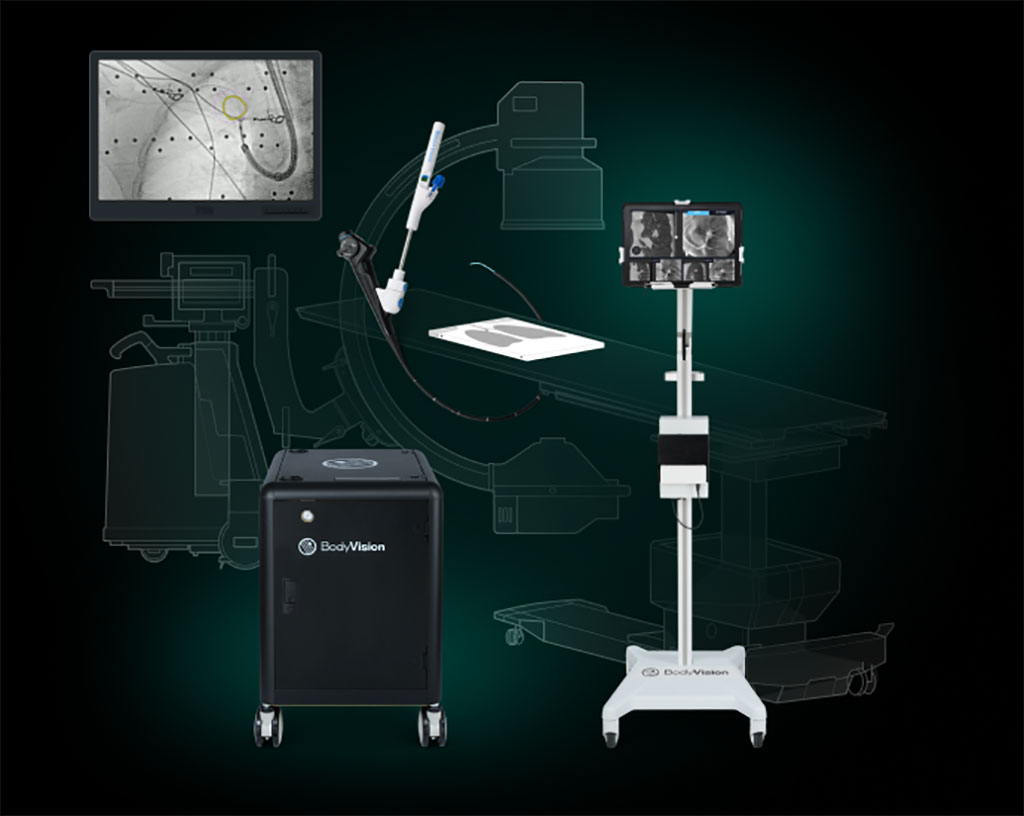AI-Driven Intraoperative CT Imaging System Sets New Standard in Lung Cancer Diagnostics
|
By HospiMedica International staff writers Posted on 15 Dec 2022 |

Lung cancer is the second most common cancer and the deadliest cancer in the U.S. The best approach to reduce mortality from lung cancer is prevention. Short of that, the goal is early diagnosis. Detecting lung cancer earlier means there is a greater chance that it can be cured. Increased early detection through low-dose CT scans is an important step to diagnosing more lung cancer patients at an earlier stage where it is more likely for their cancer to be cured. A CT scan is more effective at showing lesions on the lung than routine chest X-rays which is why it is the gold standard for lung cancer diagnostics.
Once a suspicious pulmonary lesion is seen on a CT scan, a typical next step is to take a biopsy of the lesion to determine whether it is cancerous. Bronchoscopic biopsy has emerged as the most common modality used for the diagnosis of suspicious pulmonary lesions. Pulmonologists, who perform this minimally-invasive procedure, navigate a bronchoscope to the lesion to obtain tissue samples for diagnosis. Historically, this has proven difficult because pulmonologists lacked any real-time, intraoperative imaging technology to help them accurately navigate to the lesion and visually confirm that they were obtaining tissue samples from within the lesion. In these cases, they were forced to rely on pre-operative images to guide them and randomized blind sampling strategies in an attempt to overcome this deficit. An AI-driven, intraoperative CT imaging system addresses this by enabling pulmonologists to visualize the actual lesion and lesion location intraoperatively using only a standard C-arm.
Body Vision Medical’s (Campbell, CA, USA) LungVision System uses artificial intelligence (AI) to transform X-ray images from any C-arm into real-time, intraoperative CT scans. This empowers bronchoscopists to biopsy from smaller, more difficult-to-access lung lesions at an earlier stage, thus maximizing the likelihood of an early diagnosis for lung cancer patients and improving odds for survival. Using the LungVision System, pulmonologists can navigate to the lesion with unerring accuracy and biopsy with confidence because they can see that they are sampling from within the lesion. This dramatically increases the likelihood of a definitive diagnosis for potential lung cancer patients and is revolutionizing the way pulmonologists diagnose lung cancer. The LungVision AI-driven, intraoperative CT imaging system has now been used in 2,000 diagnostic bronchoscopy procedures worldwide.
"2,000 cases is a significant achievement for us at Body Vision Medical," said David Webster, CEO of Body Vision Medical. "Body Vision was founded with the vision of transforming how diagnostic bronchoscopy is performed and the fact that LungVision is now routinely used by interventional pulmonologists and thoracic surgeons in multiple markets is real-world evidence that we are accomplishing what we had set out to do."
Related Links:
Body Vision Medical
Latest Surgical Techniques News
- Robotic Assistant Delivers Ultra-Precision Injections with Rapid Setup Times
- Minimally Invasive Endoscopic Surgery Improves Severe Stroke Outcomes
- Novel Glue Prevents Complications After Breast Cancer Surgery
- Breakthrough Brain Implant Enables Safer and More Precise Drug Delivery
- Bioadhesive Sponge Stops Uncontrolled Internal Bleeding During Surgery
- Revolutionary Nano Bone Material to Accelerate Surgery and Healing
- Superior Orthopedic Implants Combat Infections and Quicken Healing After Surgery
- Laser-Based Technique Eliminates Pancreatic Tumors While Protecting Healthy Tissue
- Surgical Treatment of Severe Carotid Artery Stenosis Benefits Blood-Brain Barrier
- Revolutionary Reusable Duodenoscope Introduces 68-Minute Sterilization
- World's First Transcatheter Smart Implant Monitors and Treats Congestion in Heart Failure
- Hybrid Endoscope Marks Breakthrough in Surgical Visualization
- Robot-Assisted Bronchoscope Diagnoses Tiniest and Hardest to Reach Lung Tumors
- Diamond-Titanium Device Paves Way for Smart Implants that Warn of Disease Progression
- 3D Printable Bio-Active Glass Could Serve as Bone Replacement Material
- Spider-Inspired Magnetic Soft Robots to Perform Minimally Invasive GI Tract Procedures
Channels
Critical Care
view channel
CPR Guidelines Updated for Pediatric and Neonatal Emergency Care and Resuscitation
Cardiac arrest in infants and children remains a leading cause of pediatric emergencies, with more than 7,000 out-of-hospital and 20,000 in-hospital cardiac arrests occurring annually in the United States.... Read more
Ingestible Capsule Monitors Intestinal Inflammation
Acute mesenteric ischemia—a life-threatening condition caused by blocked blood flow to the intestines—remains difficult to diagnose early because its symptoms often mimic common digestive problems.... Read more
Wireless Implantable Sensor Enables Continuous Endoleak Monitoring
Endovascular aneurysm repair (EVAR) is a life-saving, minimally invasive treatment for abdominal aortic aneurysms—balloon-like bulges in the aorta that can rupture with fatal consequences.... Read more
Wearable Patch for Early Skin Cancer Detection to Reduce Unnecessary Biopsies
Skin cancer remains one of the most dangerous and common cancers worldwide, with early detection crucial for improving survival rates. Traditional diagnostic methods—visual inspections, imaging, and biopsies—can... Read moreSurgical Techniques
view channel
Robotic Assistant Delivers Ultra-Precision Injections with Rapid Setup Times
Age-related macular degeneration (AMD) is a leading cause of blindness worldwide, affecting nearly 200 million people, a figure expected to rise to 280 million by 2040. Current treatment involves doctors... Read more
Minimally Invasive Endoscopic Surgery Improves Severe Stroke Outcomes
Intracerebral hemorrhage, a type of stroke caused by bleeding deep within the brain, remains one of the most challenging neurological emergencies to treat. Accounting for about 15% of all strokes, it carries... Read morePatient Care
view channel
Revolutionary Automatic IV-Line Flushing Device to Enhance Infusion Care
More than 80% of in-hospital patients receive intravenous (IV) therapy. Every dose of IV medicine delivered in a small volume (<250 mL) infusion bag should be followed by subsequent flushing to ensure... Read more
VR Training Tool Combats Contamination of Portable Medical Equipment
Healthcare-associated infections (HAIs) impact one in every 31 patients, cause nearly 100,000 deaths each year, and cost USD 28.4 billion in direct medical expenses. Notably, up to 75% of these infections... Read more
Portable Biosensor Platform to Reduce Hospital-Acquired Infections
Approximately 4 million patients in the European Union acquire healthcare-associated infections (HAIs) or nosocomial infections each year, with around 37,000 deaths directly resulting from these infections,... Read moreFirst-Of-Its-Kind Portable Germicidal Light Technology Disinfects High-Touch Clinical Surfaces in Seconds
Reducing healthcare-acquired infections (HAIs) remains a pressing issue within global healthcare systems. In the United States alone, 1.7 million patients contract HAIs annually, leading to approximately... Read moreHealth IT
view channel
Printable Molecule-Selective Nanoparticles Enable Mass Production of Wearable Biosensors
The future of medicine is likely to focus on the personalization of healthcare—understanding exactly what an individual requires and delivering the appropriate combination of nutrients, metabolites, and... Read moreBusiness
view channel
Philips and Masimo Partner to Advance Patient Monitoring Measurement Technologies
Royal Philips (Amsterdam, Netherlands) and Masimo (Irvine, California, USA) have renewed their multi-year strategic collaboration, combining Philips’ expertise in patient monitoring with Masimo’s noninvasive... Read more
B. Braun Acquires Digital Microsurgery Company True Digital Surgery
The high-end microsurgery market in neurosurgery, spine, and ENT is undergoing a significant transformation. Traditional analog microscopes are giving way to digital exoscopes, which provide improved visualization,... Read more
CMEF 2025 to Promote Holistic and High-Quality Development of Medical and Health Industry
The 92nd China International Medical Equipment Fair (CMEF 2025) Autumn Exhibition is scheduled to be held from September 26 to 29 at the China Import and Export Fair Complex (Canton Fair Complex) in Guangzhou.... Read more









.jpg)




